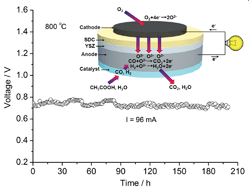Renewable acetic acid in combination with solid oxidefuel cells for sustainable clean electric power generation†
Abstract
The feasibility of renewable acetic acid as a direct

* Corresponding authors
a
State Key Laboratory of Materials-Oriented Chemical Engineering, College of Chemistry & Chemical Engineering, Nanjing University of Technology, No. 5 Xin Mofan Road, Nanjing, P.R. China
E-mail:
shaozp@njut.edu.cn
Fax: +86 25 8317 2242
Tel: +86 25 8317 2256
b
Department of Chemical Engineering, Curtin University, Perth, Australia
E-mail:
shaomin.liu@curtin.edu.au
Tel: +61 8 92669056
The feasibility of renewable acetic acid as a direct

 Please wait while we load your content...
Something went wrong. Try again?
Please wait while we load your content...
Something went wrong. Try again?
C. Su, W. Wang, R. Ran, Z. Shao, M. O. Tade and S. Liu, J. Mater. Chem. A, 2013, 1, 5620 DOI: 10.1039/C3TA10538E
To request permission to reproduce material from this article, please go to the Copyright Clearance Center request page.
If you are an author contributing to an RSC publication, you do not need to request permission provided correct acknowledgement is given.
If you are the author of this article, you do not need to request permission to reproduce figures and diagrams provided correct acknowledgement is given. If you want to reproduce the whole article in a third-party publication (excluding your thesis/dissertation for which permission is not required) please go to the Copyright Clearance Center request page.
Read more about how to correctly acknowledge RSC content.
 Fetching data from CrossRef.
Fetching data from CrossRef.
This may take some time to load.
Loading related content
